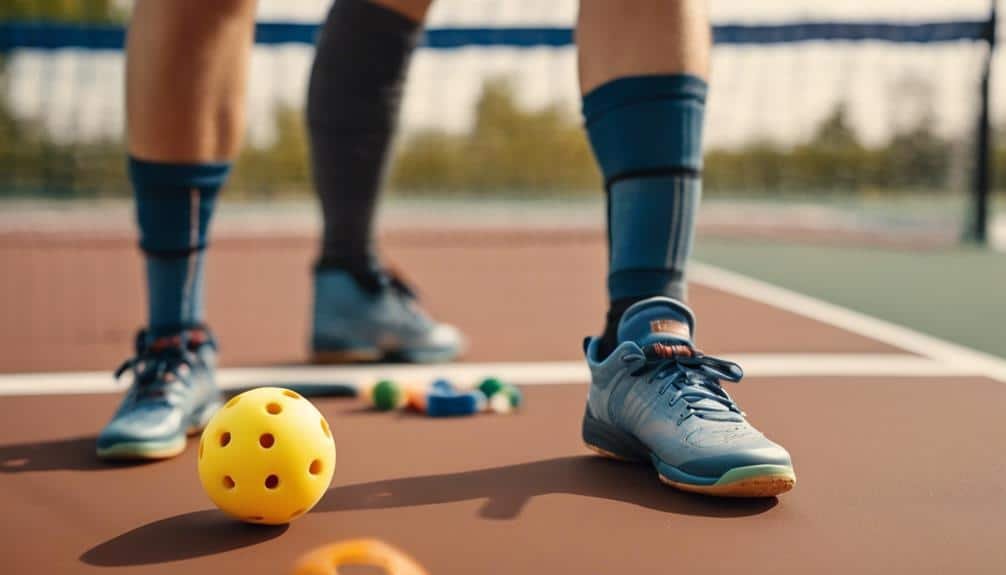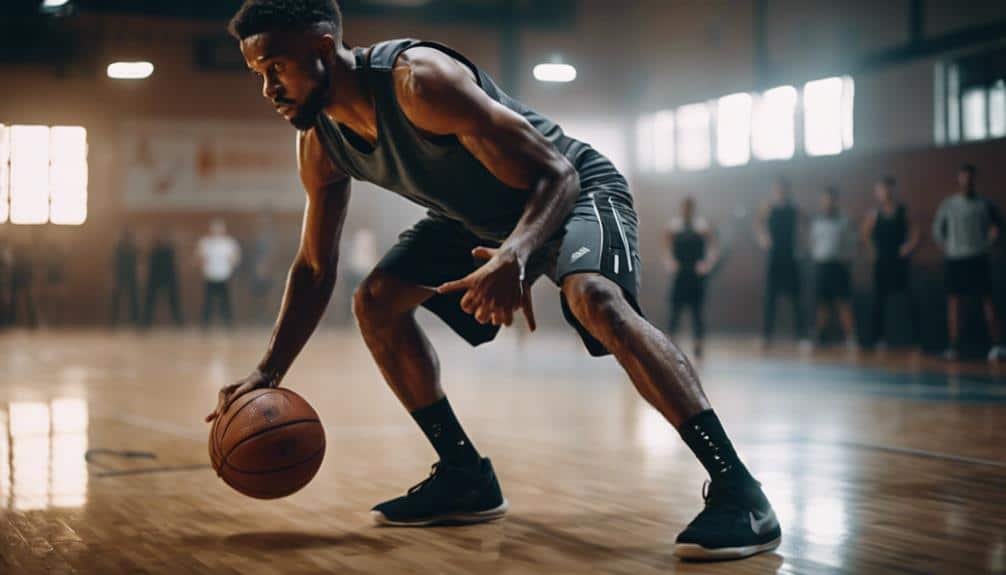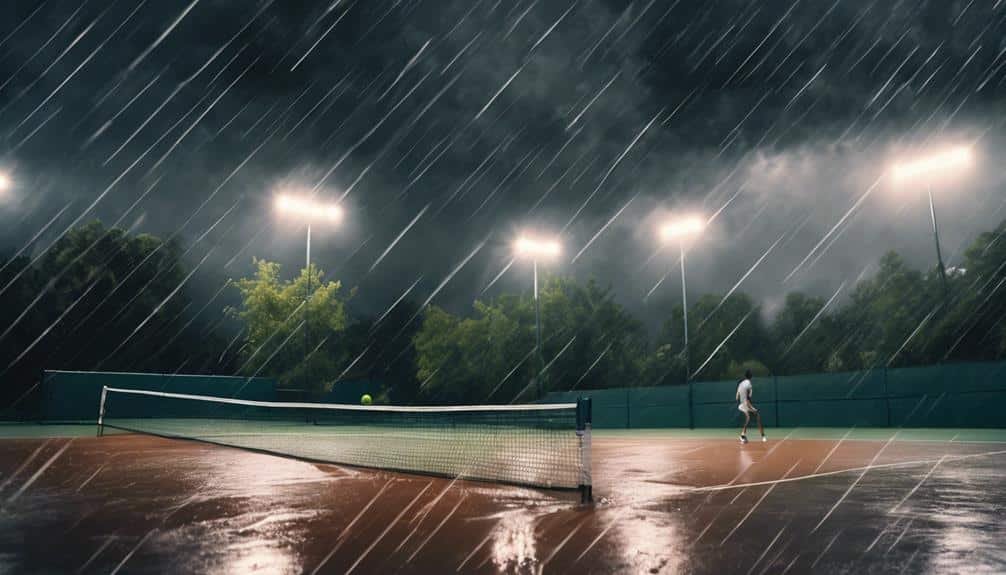I've uncovered the hidden secrets to court safety in pickleball, and they're not what you'd expect. It's not just about avoiding obvious hazards; it's a holistic approach. Proper footwork, maintaining balance, and stress reduction are crucial. I've found that equipment checks, injury prevention exercises, and adhering to court etiquette play vital roles. Weather considerations can't be overlooked, and recovery tips are essential for long-term safety. By focusing on these areas, I've dramatically reduced my risk of injury. But there's more to it than meets the eye. The real game-changers lie in the details of each safety aspect.
Key Takeaways
- Regularly inspect the court for hazards like debris, uneven surfaces, or water puddles before play.
- Implement proper footwork techniques, focusing on balance and agility to prevent injuries.
- Prioritize warm-up and cool-down routines, including dynamic stretches and sport-specific movements.
- Practice court etiquette, such as announcing scores and calling 'ball on court' to maintain safety.
- Adapt to weather conditions by wearing appropriate attire and taking necessary precautions.
Common Pickleball Court Injuries

Pickleball enthusiasts should be aware of the most prevalent injuries that can sideline players and hinder their enjoyment of the game.
I've seen firsthand how injury patterns can emerge on the court, often stemming from excessive movement and poor technique. Common issues include strains, sprains, and overuse injuries, particularly in the lower body and shoulders.
Court hazards like uneven surfaces or debris can also lead to trips and falls.
I've noticed that many players underestimate the importance of proper footwork and body positioning. This oversight can result in sudden twists or awkward landings, putting undue stress on joints and muscles.
It's crucial to recognize these potential risks and take proactive steps to prevent them. By understanding these common injuries, we can work together to create a safer playing environment and ensure everyone stays in the game they love.
Proper Footwork Techniques
One's footwork can make or break their performance on the pickleball court, serving as the foundation for agility, balance, and injury prevention.
I've seen countless players struggle with pickleball agility due to poor footwork.
To improve your court efficiency, focus on maintaining a calm body while hitting the ball.
It's crucial to balance yourself and come out of the cross step before changing direction.
This technique will help you move more efficiently and reduce the risk of injury.
Maintaining Balance While Playing

Building on proper footwork, maintaining balance is a cornerstone of safe and effective pickleball play.
I've learned that body positioning is crucial for staying balanced on the court. I always remind myself to keep my weight centered and my knees slightly bent, ready to react. Regular balance checks during gameplay help me stay aware of my stability.
I make it a habit to quickly assess my stance after each shot, ensuring I'm not overextending or leaning too far in any direction.
We pickleball enthusiasts know that a stable base is key to avoiding injuries and improving our game.
By focusing on balance, we're not only protecting ourselves but also enhancing our performance. I encourage my fellow players to practice balance drills off-court, too.
This dedication to stability will pay off in smoother movements and reduced risk of falls during intense rallies.
Stress Reduction Strategies
To keep our game enjoyable and injury-free, it's crucial we develop effective stress reduction strategies for the pickleball court.
As a community of players, we must prioritize mental reframing and maintain a healthy game perspective.
I've found that implementing these stress-reduction techniques can significantly improve our experience:
Focus on fun and socializing, rather than intense competition.
Practice deep breathing exercises between points.
Cultivate a positive mindset by celebrating small victories.
Engage in pre-game visualization to calm nerves.
Equipment Safety Considerations

After addressing stress reduction, we must turn our attention to the critical aspect of equipment safety in pickleball.
As a dedicated player, I can't stress enough the importance of regular paddle inspections. I always check my paddle for cracks, chips, or loose grips before each game. It's not just about performance; it's about preventing potential injuries from faulty equipment.
Court cleaning is another crucial safety measure we often overlook. I make it a point to scan the court for debris, water puddles, or any hazards before playing. It's our collective responsibility to maintain a safe playing environment.
Warm-up and Cool-down Routines
Proper warm-up and cool-down routines are essential components of injury prevention in pickleball that I've found to be often overlooked by casual players. As a dedicated enthusiast, I've learned that incorporating flexibility exercises and dynamic stretches can significantly reduce the risk of strain and improve performance.
I start with a 5-minute light jog or brisk walk. I then perform dynamic stretches focusing on major muscle groups. Next, I practice sport-specific movements like lunges and quick side-steps. Finally, I finish with gentle static stretches post-game.
I can't stress enough how crucial these habits are for our pickleball community. By prioritizing warm-ups and cool-downs, we're not just safeguarding our bodies; we're ensuring longevity in the sport we love. Remember, taking care of ourselves means more time on the court with our fellow players.
Injury Prevention Exercises

I've found that incorporating specific exercises into your routine can significantly reduce the risk of injuries on the pickleball court.
As a seasoned player, I've learned the importance of pickleball stretches and injury screens.
Before each game, I focus on dynamic stretches that target key muscle groups used in pickleball, such as hamstrings, quadriceps, and shoulders.
These exercises help improve flexibility and prepare your body for the quick movements required on the court.
Additionally, I recommend performing regular injury screens to identify potential weaknesses or imbalances.
These screens can help you address issues before they become problematic.
For example, a simple balance test can reveal areas that need strengthening.
By consistently practicing these preventative measures, you'll not only reduce your risk of injury but also improve your overall performance.
Court Etiquette for Safety
When you step onto the pickleball court, it's crucial to understand that safety isn't just about your own actions, but also how you interact with others.
Court manners and player respect play a vital role in ensuring everyone's well-being. As a seasoned player, I've learned that proper etiquette can prevent accidents and create a positive atmosphere.
- Announce the score clearly before serving
- Call 'ball on court' immediately if you spot a stray ball
- Yield to players on adjacent courts when retrieving balls
- Avoid walking behind active players during points
Weather-Related Safety Precautions

While court etiquette is key for safety, players must also stay vigilant about weather conditions that can pose significant risks on the pickleball court.
I've learned that extreme temperatures, rain, and wind can quickly turn a fun game into a dangerous situation. That's why I always check the forecast before heading out to play.
In hot weather, I'm careful to wear appropriate pickleball attire – lightweight, breathable fabrics that wick away sweat. I also make sure to apply sunscreen before playing and reapply during breaks.
On particularly scorching days, I bring extra water and take frequent rest periods in the shade.
When it's cold, I layer up and do a thorough warm-up to prevent muscle strains.
If rain starts falling, I immediately stop playing to avoid slips and falls on the wet court surface.
Recovery Tips for Players
Every pickleball player should prioritize post-game recovery to maintain peak performance and prevent long-term injuries.
As a dedicated player, I've learned that effective recovery is crucial for our continued success on the court.
Implement active rest strategies, such as light stretching or walking, to promote blood flow and reduce muscle stiffness.
Apply ice to any areas of discomfort for 15-20 minutes to manage pain and minimize inflammation.
Stay hydrated by drinking plenty of water before, during, and after play to support muscle recovery.
Get adequate sleep, aiming for 7-9 hours per night, to allow your body to repair and regenerate.
Conclusion
I've shared these court safety secrets to help you enjoy pickleball without fear of injury.
Remember, 60% of pickleball injuries are preventable with proper technique and awareness.
By implementing these strategies, you'll significantly reduce your risk on the court.
Stay vigilant, maintain proper form, and always prioritize safety.
With these tools in your arsenal, you're well-equipped to play confidently and safely.
Now get out there and enjoy the game!

